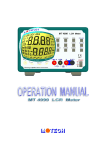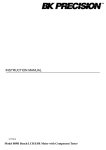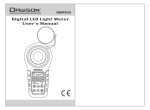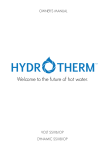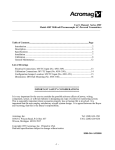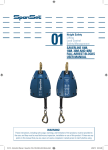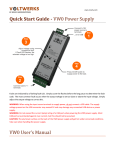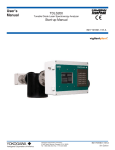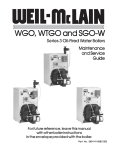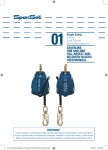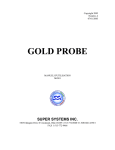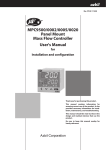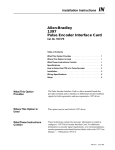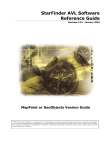Download Addendum Instruction Manual
Transcript
1 TDLS200 Tunable Diode Laser Analyzer Addendum Instruction Manual Furnaces, Heaters & Large Scale Combustion IM11Y01B01-12E-A 2nd Edition 2 This ADDENDUM to Instruction Manual has been compiled for Owners/Operators of the Model TDLS200 Tunable Diode Laser Analyzer specifically for installations on Furnaces, Heaters and Large Scale Combustion process ©Copyright 2012 by Yokogawa Laser Analysis Division All Rights Reserved Product development is a continuous policy of Yokogawa Laser Analysis Division and therefore specifications may be subject to change without notice. SAFETY should be considered first and foremost importance when working on the equipment described in this manual. All persons using this manual in conjunction with the equipment must evaluate all aspects of the task for potential risks, hazards and dangerous situations that may exist or potentially exist. Please take appropriate action to prevent ALL POTENTIAL ACCIDENTS. AVOID SHOCK AND IMPACT TO THE ANALYZER THE LASERS CAN BE PERMANENTLY DAMAGED Laser Safety & Classification according to FDA Regulations. The TDLS200 is registered with the United States FDA as a Laser Product Please carefully read the appropriate Sections of this User Guide. The TDLS200 Tunable Diode Laser (TDL) Analyzer is a technologically advanced instrument that requires the appropriate care when handling, installing and operating. Failure to do so may result in damage and can void any warranties! If there is any doubt about any aspect of the Instrument or its use, the please contact Yokogawa Laser Analysis Division and/or your authorized Representative/Distributor. In this addendum to the Users Guide for TDLS200, the installation to Furnaces, Heaters and Large Scale Combustion is specifically outlined. Items contained IM11Y01B01-12E-A 2nd Edition 3 within this addendum supersede any conflicting statement contained within the standard Users Guide. IM11Y01B01-12E-A 2nd Edition 4 1 Combustion Overview 1.1 Introduction In this addendum to the Users Guide for TDLS200, the installation for combustion is detailed. This information pertains to oxygen and CO/CH4 analyzers. Some typical combustion related installations are outlined below: • Ethylene Cracking Furnaces, Refinery Heaters, Reformer Units, VCM Cracking Furnaces, Waste Incineration, Power Generation systems, etc. • Radiant section, OPL 1-30m (~99ft), +/- atmospheric pressure, <1200C (~2200F): o Oxygen 0-21% - for control or monitoring o CO 0-5,000ppm – for control, monitoring or safety + CH4 0-5% - breakthrough monitoring and/or safety <800C (~1475F) • Convection-Economizer section, OPL 1-30m (~99ft), +/- atmospheric pressure, <1200C (~2200F): o Oxygen 0-21% - for control or monitoring o CO 0-5,000ppm – for control, monitoring or safety + CH4 0-5% - breakthrough monitoring and/or safety <800C (~1475F) • Combustion flue, OPL 1-10m (~33ft), +/- atmospheric pressure, <500C (~930F): o Oxygen 0-21% - for control or monitoring o CO 0-5,000ppm – for control, monitoring or safety + CH4 0-5% - breakthrough monitoring and/or safety <800C (~1475F) • Waste Incineration, OPL 1-10m (~33ft), +/- atmospheric pressure, <1200C (~2200F): o Oxygen 0-21% - for control or monitoring o CO 0-5,000ppm – for control, monitoring or safety + CH4 0-5% - breakthrough monitoring and/or safety <800C (~1475F) For in-situ application (typically large scale combustion) the optical path lengths are generally very long (7-30m for large scale combustion and ethylene furnaces). Standard TDL optics and laser beam configurations are unsuitable because of the mechanical stability of these large scale combustion systems. Yokogawa Laser Analysis Division therefore designed and developed the concept of a diverging beam (i.e. a laser beam that expands over distance) and a large aperture optics detector scheme (i.e. a large target for the laser to hit). The general concept of diverging beam and large aperture optics is shown below: IM11Y01B01-12E-A 2nd Edition 5 In a standard TruePeak TDLS200 analyzer, the laser beam exiting the launch unit is normally collimated parallel before hitting the opposing detect unit. The collimated beam size is typically less than 1” diameter. However, this optical layout is not appropriate for long-path applications (the dimension of process is longer than 23’). During the initial installation, it is also not so easy to align the laser beam so that it can hit the targeted detect unit over a long distance (small changes in the launch unit angle are magnified over long distances). Also it is almost impossible to keep good alignment with varying ambient and process conditions – especially during cold starts and shutdowns (the most extreme thermal changes on the mechanical structures). To resolve the above issues, Yokogawa Laser Analysis Division has developed diverging beam and large aperture optics strategy. At the launch side, the output laser beam has a small diverging angle. For example, the beam size is about 20” (~50cm) diameter at 60’ (~18m) optical distance. The optical aperture at the detect unit is enlarged from original diameter. With these two changes, it is much easier to do initial alignment and keep good transmission at all operating conditions. It is however, still important to mechanically strengthen the analyzer attachment nozzles onto the combustion unit walls. IM11Y01B01-12E-A 2nd Edition 6 2 Installation 2.1 Process Measurement Point Considerations The following criteria should be considered when selecting the installation point in respect to the process conditions: • Process Gas Flow Conditions – Laminar, homogenous gas concentration distribution conditions across the measurement point are recommended. For circular ducts/stacks this condition is generally at least three unimpaired diameters (D) before and after a process bend. For rectangular cross sections, the hydraulic duct diameter (D) is derived from: D = (4 x duct cross sectional area) / duct circumference If neither situation exists or is possible, then distribution of the unimpaired section of duct should be 66% on the inlet side and 34% on the outlet side. Profiling of the proposed measurement point may be required to ensure that a correct installation point is selected. • Process Gas Temperature – It is recommended that the analyzer be installed at a location where temperature fluctuations are minimized. Generally as a guide, if the temperature of the gas at the point where the analyzer is to be installed is to vary by more than +/-10oC (+/18oF) then an “Active” input signal should be used for compensation. Ensure the analyzer has been selected and configured to suit the maximum operating gas temperature. • Process Gas Pressure – It is recommended that the analyzer be installed at a location where pressure fluctuations are minimized. Generally as a guide, if the temperature of the gas at the point where the analyzer is to be installed is to vary by more than +/-0.05Bar (+/0.725psi) then an “Active” input signal should be used for compensation. Ensure the analyzer has been selected and configured to suit the maximum operating gas pressure. Ensure the process isolation windows have been selected and configured to suite the maximum design gas pressure. • Process Dust/Particulate Matter – It is recommended that the analyzer be installed at a location where dust loadings are minimized. Dust and other particulate matter will reduce the optical transmission of the measuring laser beam. Within limits, the loss of optical transmission does not affect the measurement however a Warning alarm will be initiated when the transmission falls below allowable limits. The amount of dust loading is also dependent upon the optical path length – Consult Factory for further details. IM11Y01B01-12E-A 2nd Edition 7 Window Purge Gas Flow Adjustment – While there is no specific formula for this purge gas flow rate (due to the many variables/complexity), we include the following information that might help optimize the window purge gas flow rates actually at site. As mentioned in the User’s Guide, the window purge flow rate can vary by application from as little as 5 lts./min up to as much as 50 lts./min for typical process applications. There are a couple of methods that can be used to help establish a suitable flow rate. For relatively short optical path lengths (such as process O2 measurements) if there is too much flow the purge gas will protrude/mix into the process gas slightly and therefore possibly cause a slightly shorter actual optical path length (readings lower than expected). Conversely, if there is too little window purge flow the process gas may protrude/mix with the purge gas (worst case contaminate the windows) in the connection nozzle and possibly cause a slightly longer actual optical path (readings higher than expected). One method that can be used (if the process gas is not excessively dirty or wet) would be to measure the process gas without purge for a short period of time. Before starting this test, the process measurement (O2 concentration) should be relatively stable and not expected to change within a few minutes. First, establish the distance between the launch unit window and the detect unit window and enter this value as the Process Path Length (under Advanced Menu, Configure). Then stop the process window purge gas flow to both the launch and detect units while observing the transmission – note, if there is a sudden large decrease in transmission then probably contamination/fouling has occurred on the windows! Wait for the process reading to stabilize (i.e. the process gas has filled the nozzle and alignment bellows sections up to each window), take note of the measurement value and resume some window purge flow. Change the Process Path Length back to the normal value and now resume/adjust the launch and detect unit window purges until the process reading matches the value noted when there was no purge flow. If the transmission does not return to its original value then the process windows will have to be cleaned to ensure optimal operation. It is best to repeat this procedure two or three times to ensure repeatable results that establish confidence in the readings. This can be repeated at any time at a later date to verify the process readings. A similar method can also be used by comparing ratios of the path lengths and measurements with and without window purge flow. Using the analyzers integral Trend function, observe the measurement values when both launch and detect window purge gas flows are simultaneously stopped (for approx. 30 seconds or until the reading stabilizes) and then resume window purge flow back to the initial flow rates. As with the other method, observe the transmission – note, if there is a sudden large decrease in transmission then probably contamination/fouling has occurred on the windows! Once the process measurement has re-stabilized with window purge gas flow, repeat the simultaneous stopping of window purge gas flow. Repeat this several times until the trend screen clearly shows repeatable measurement results with and without window purge. If the transmission does not return to its original value then the process windows will have to be cleaned to ensure optimal operation. The ratio of these two measurements can now be established based on the repeatable results obtained. Establish the distance between the launch unit window and the detect unit window and calculate the ratio with respect to the normal Process Path Length. The ratio of ‘measurement without purge gas to measurement with purge gas’ should be equal to ‘path length window-window to process path length’ – thus indicating that the connection nozzles are purged correctly. IM11Y01B01-12E-A 2nd Edition 8 2.2 Position of Process Flanges for Launch and Detect Units: Process flanges should be located on the process such that the Launch and Detect Units can be installed, accessed removed in a safe and convenient manner. The following criteria/Check List should be met at a minimum: • Good, Safe Engineering practices • Local codes and regulations for such equipment installation • Appropriate hazardous area (if applicable) precautions • Owner Company best practice and engineering standards • Access for personnel to stand in front of launch and Detect Units • Clearance for installation and removal of Launch and Detect (see below) • Clearance for installation and removal of purge insertion tubes (if applicable) • Access to process isolation valves • Safe routing for interconnecting cables • Ambient conditions in accordance with analyzer limits • Access to appropriate utilities • Adjacent space for mounting to Calibration Cell when off-line IM11Y01B01-12E-A 2nd Edition 9 Clearance for Launch Unit: Ensure there is sufficient clearance and access for the Launch unit: IM11Y01B01-12E-A 2nd Edition 10 Clearance for Detect Unit: Ensure there is sufficient clearance and access for the Detect unit: IM11Y01B01-12E-A 2nd Edition 11 Dimensions for combustion process interface devices: Above: 3” 150# ANSI RF (option for Launch unit alignment bellows) Above: 4” 150# ANSI RF (option for Launch unit alignment bellows) Above: 4” 150# ANSI RF Large Aperture Optics (detect side, LAO) IM11Y01B01-12E-A 2nd Edition 12 The standard flange sizes are either 2” 3” or 4” 150# R.F. ANSI as well as DN50 and DN80. Please check the exact flange size specified and provided for the particular installation. Other flange sizes and a variety of materials (to suit the process) are available so please check these details prior to installing the flanges on the process. The process isolation valves should have at least a 95% diameter clear bore size (aperture) to ensure there is sufficient tolerance to align the laser beam after installation. Ducts and Stacks that have thin and flexible walls should be reinforced to ensure that the laser beam alignment is maintained at all times. Rigid mounting for the process flanges is highly recommended to ensure alignment is maintained. In situations where the process flanges are mounted to these thin and flexible duct/stack walls, a larger reinforcing plate should be welded around the mounting flange area to increase the attaching region. The figure below depicts a typical suggestion however; it is the installer’s responsibility to ensure appropriately rigid installation is provided for the analyzer. Below: Typical 24” x 24” x 3/8” reinforcement plate. This approach is NOT suitable for systems that use the Large Aperture Optics (LAO) detect unit, these are typically installed on applications with at least 7m (21ft) optical path length. For these long path length installations, more significant bracing and structural rigidity is required – refer to following section: IM11Y01B01-12E-A 2nd Edition 13 Process Flange Welding Alignment and Line-Up The Launch and Detect units are provided with alignment mechanisms that allow for some manual adjustment of the laser beam direction in both planes. It is however recommended that the following angular tolerances be adhered to as closely as possible. IM11Y01B01-12E-A 2nd Edition 14 IM11Y01B01-12E-A 2nd Edition 15 IM11Y01B01-12E-A 2nd Edition 16 Details of supporting structural steel for long optical path length systems (>7m/21ft): It is important that the angle support steel (used for supporting the nozzle) be welded directly to both the walls and the adjacent heater/furnace structural steel as shown conceptually below – Note; horizontal/vertical bracing tied to the adjacent structural steel and walls of the unit: Diagram below shows the ‘preferred’ nozzle reinforcement method: NOTE: Ensure you have sufficient clearance behind the flange between the angle support to allow for the alignment flange and LAO attachment using appropriate nuts and bolts/studs! IM11Y01B01-12E-A 2nd Edition 17 ≥10” ≥10” Note: The TDLS200 flange must be at least 10” from the furnace wall. Heat will damage the optics at distances less than 10” from the furnace wall!!! The above preferred method may not be possible in every site specific situation. The actual dimensions may have to be adjusted to suit the practical installation considerations in each case but it should remain as close as possible to the above ‘preferred’ method. IM11Y01B01-12E-A 2nd Edition 18 Case A below shows this preferred method and case B below shows an alternative method if the ‘preferred’ method cannot be accommodated at the particular site installations: Above – Preferred angle mounting above – Alternate angle mounting Below: Image of actual installation as Case A – preferred method IM11Y01B01-12E-A 2nd Edition 19 Mounting the Launch and Detect Units to the Process Flange Securely bolt the Launch and Detect (LAO) Units to the process flanges using the standard bolt holes/studs provided. Ensure the correct size bolts, nuts, and gasket are used in accordance with the flange specifications and in accordance with the process specifications when applicable. CAUTION: Use anti-seize paste on threads to avoid possible metallic galling on nuts/bolts/studs! START flow to the clean dry window purge gases as soon as possible if the process valve is open – this will prevent contamination to the optical surfaces. Before starting the actual purge flows, ensure the lines have been blown out to remove all debris, dirt, oil, water and other media that could contaminate the optical surfaces and impaired the optical transmission/measurement performance. NOTE: the optical surface temperatures MUST NOT exceed 70degC!!! NOTE: If the process isolation valve flange is excessively hot due to the process temperature or radiant heat, then a thermal insolating flange gasket should be used in order to minimize the heat transfer to the analyzer flange face. It is generally beneficial to make the flange of the Launch and Detect Units and the flange of the process concentric with each other. Due to the large clearance provided by standard flanges and bolts, it is possible to mount the two flanges in an un-concentric manner – this should be avoided to aid laser beam alignment. IM11Y01B01-12E-A 2nd Edition 20 3 Installation 3.1 Adjustment and Optimization of Alignment - <600oC (1100oF) Installations: The following procedure will aide in performing an alignment of the TDLS200 analyzer. The procedure will guide the technician through the necessary steps to align and optimize the signal of the analyzer. Please read the entire procedure before starting work and ask your local Yokogawa service group for further information if required. This procedure can also be performed by local Yokogawa service personnel if required – please contact for further details. The alignment of the analyzer will be accomplished by first, visually aligning the analyzer horizontally and vertically. By performing this first step, the signal should be adequate to begin the alignment procedure. Once a visual alignment is achieved and a signal is present, the optimization of the alignment will be accomplished by “sweeping” the launch beam across the detector beam. Alignment of the detector may be necessary to insure a signal is present. This is accomplished by monitoring the transmission strength while adjusting the top/bottom and left/right nuts on the alignment bellows. The adjustments are performed on one axis at a time. The intent is to use the alignment bellows adjustments to move the beam from one edge of the detector to the other (both horizontally and vertically), while counting the number of ¼ turns of the nuts required to sweep across the detector. The beam is then centered by taking the number of ¼ turns necessary to sweep the analyzer from one signal edge to the other and dividing this number in half and returning the analyzer to the center by turning the nuts so that the beam is centered. Example, begin by monitoring the transmission and turning the top/bottom screws so that that the beam reaches one edge of the detector, this will be noticed by a drop in transmission. Once on the edge, begin turning the nuts the opposite direction a ¼ turn at a time until you see an increase in the transmission and then a decrease and eventually a loss of transmission again. If this required 18 (¼) turns to accomplish, turn the nuts back ½ of that amount, or 9 (¼) turns to center the beam. Repeat this process for the left/right axis. The launch unit will then be centered. Please refer to the following pictorial guide for further details. IM11Y01B01-12E-A 2nd Edition 21 IM11Y01B01-12E-A 2nd Edition 22 Above: Zero Transmission/No Signal Above: 0.2% Transmission/small signal IM11Y01B01-12E-A 2nd Edition 23 • • • Once visual alignment is achieved on both the launch and detect and clean, dry purge gas has been flowing, power may be applied to the analyzer. Begin the alignment process by starting at the launch end; maximize the signal (using the transmission signal and value) by moving the launch around using the alignment bellows. Once maximum signal is achieved, move to the detect end and using the method described in the previous slide, move the LAO/detect assembly around, until maximum signal is achieved. (Note: CO detectors are more sensitive to miss-alignment than the O2 detector) IM11Y01B01-12E-A 2nd Edition 24 • • • The launch and detect alignment steps may need to be repeated several times to ensure maximum transmission. Once maximum transmission is achieved, move to the next step and ensure the laser is centered. This is done by “sweeping” the laser across the detector in both the horizontal and vertical axis. To accomplish this, use the nuts on the launch alignment bellows to “sweep” the beam. IM11Y01B01-12E-A 2nd Edition 25 IM11Y01B01-12E-A 2nd Edition 26 IM11Y01B01-12E-A 2nd Edition 27 IM11Y01B01-12E-A 2nd Edition 28 3.2 Adjustment and Optimization of Alignment - <1200oC (2200oF) Installations: This section will aide in the alignment of the large aperture optics assembly in a high temperature (i.e. with variable degree of background radiation >800oC) application using an oscilloscope (or scope-meter). Please read the entire procedure before starting work and ask your local Yokogawa service group for further information if required. This procedure can also be performed by local Yokogawa service personnel if required – please contact for further details. Please note that this procedure is not intended to teach/train someone how to use an oscilloscope! If you do not know how to use an oscilloscope, please align the analyzer by using the method mentioned in the user manual. IM11Y01B01-12E-A 2nd Edition 29 IM11Y01B01-12E-A 2nd Edition 30 IM11Y01B01-12E-A 2nd Edition 31 IM11Y01B01-12E-A 2nd Edition 32 • • • • • • Once visual alignment is achieved on both the launch and detect, power may be applied to the analyzer. Begin the alignment process by starting at the launch unit to maximize the signal by moving the launch around using the alignment bellows while watching the scope screen. . Once maximum signal is achieved, (Note that the signal may be very small initially, as low as 0.1 volts) move to the detect end and using the method described in the previous slide, move the LAO/detect assembly around, until maximum signal is achieved. The launch and detect alignment steps may need to be repeated several times to ensure maximum transmission. Once maximum transmission is achieved, move to the next step and ensure the laser is centered. This is done by “sweeping” the laser across the detector in both the horizontal and vertical axis. To accomplish this, use the nuts on the alignment bellows to “sweep” the beam. IM11Y01B01-12E-A 2nd Edition 33 IM11Y01B01-12E-A 2nd Edition 34 IM11Y01B01-12E-A 2nd Edition 35 IM11Y01B01-12E-A 2nd Edition 36 Adjustment of Detector Gain after Optimization of Alignment – Please read these directions carefully before attempting work and contact your local Yokogawa service center if there is any doubt about how to perform this procedure. Alternatively, Yokogawa service personnel can perform this procedure – please contact you local service center for details, rates, availability, etc. Caution – Electrostatic Sensitive! INTRODUCTION • For TDLS200 measurement over long optical path length, the laser beam is usually configured with a small diverging angle (either with or without large aperture detector lens). In factory, the detector signal gain is not optimized for the real installation. During the analyzer field start up service, the detector gain needs to be adjusted to achieve the best analyzer performance. • This document gives the guidance and procedures to adjust the detector board gain for services and customers after the analyzer is installed and powered up. • This operation should be done by qualified personnel. Read instructions fully before starting this operation. Any doubts or questions, please contact Yokogawa. PHOTOS OF DETECTOR BOARD High-temp detector board (> 600°C) Low-temp detector board (< 600°C) RESISTOR KIT BAG • For a TDLS200 analyzer with diverging laser beam configuration (either with or without large aperture detector lens), a resistor bag is attached inside the detector box. The resistor bag contains the resistors with the following values. All of them are ¼ W, 5% tolerance metal film through-hole resistors. Resistor Bag for Analyzers With Diverging Beam Optics Resistance (Ω) Quantity 100 1 1k 2 1.5k 2 2.2k 2 3.3k 2 5.1k 2 7.5k 2 11k 2 15.8k 2 24.3k 2 IM11Y01B01-12E-A 2nd Edition 37 • Factory gain resistors on the detector board: R21 = ________; R22 = ________; R23 = ________. PROCEDURE 1. This procedure requires wearing a grounding strap connected to one of the grounding lugs of the analyzer to prevent any electrostatic damage. 2. Open the detector enclosure and put on a grounding strap. 3. Identify the gain resistors R21, R22 and R23 on the detector board as shown in the photo above. They are all plugged in sockets instead of being soldered, easy to be modified by a pair of small pliers. The existing gain resistors have factory resistance values optimized on a calibration cell. 4. [Optional] For a high-process-temperature application and if the current process temperature is higher than 600°C, apply a multi-meter to measure the voltage across R21. If the measured voltage absolute value is greater than 5V, change R21 to the 100Ω resistor from the resistor bag. Keep the original R21 in the resistor bag as it can be used for future off-line calibration. 5. Remove R22 and R23 from the detector board and replace them with the 11kΩ resistors from the resistor bag. Please keep the original R22 and R23 in the resistor bag as they can be used for future offline calibration. 6. Optimize the analyzer alignment for both the launch and detector sides. Stop the alignment if Detector Signal High fault activates. 7. In the TruePeak user interface software, navigate to Advanced Menu (password) -> Configure -> Laser Spectra & Control screen to check the raw detector signal. Write down the raw detector signal MAX and MIN values for later use. MAX MIN 8. Change R22 and R23 accordingly based on the current raw detector signal. Perform one item of the following selections (a, b, or c). a. If Detector Signal High fault is active, change both R22 and R23 to the next smaller value available in the resistor bag, and then go back to STEP 6. For example, if the current R22 and R23 values are 11kΩ, the new R22 and R23 values should be 7.5kΩ. NOTE: please access Active Alarm in the main user interface panel to check if Detector Signal High fault is active. b. If the raw detector signal is within requirement, remove R22 and R23 (and R21 if it was changed to 100Ω in STEP 3) and cut their leads properly to fit the sockets tight and low, and then go to STEP 9. NOTE: (1) for a low-process-temperature analyzer (with no capacitor on R3), the raw detector signal is within requirement if MAX is between 0.0 and 4.0; (2) for a IM11Y01B01-12E-A 2nd Edition 38 high-process-temperature analyzer (with a capacitor on R3), the raw detector signal is within requirement if MIN is between -4.0 and -8.5. c. If the raw detector signal is too low (other than a and b), change either R22 or R23 to the next greater value available in the resistor bag, and then go back to STEP 7. How to decide which resistor to change: i. If the current R22 value is greater than the current R23 value, change R23 to the next greater value available in the resistor bag. ii. If the current R22 value is same as the current R23 value, change R22 to the next greater value available in the resistor bag. iii. If the current R22 and R23 are already 24.3kΩ (the greatest value available in the resistor bag), please contact Yokogawa for assistance. 9. Close the detector enclosure. Write down the final values of R21, R22 and R23 below for record. R21 = ____________; R22 = ____________; R23 = ____________. 10. Enter these new resistor values into the analyzer configuration under Advanced Menu > Configure > System > Adjustable Resistors > Detect – R21, Detect – R22, and Detect – R23. All resistor values are entered in K ohm unit. 11. Keep the resistor bag and this procedure document by customer. DO NOT leave them in the detector box or throw them away. TIPS • How to remove a gain resistor? On the detector board, find the location of the gain resistor. Please note that the resistor is not soldered but resting in sockets. Carefully remove the resistor from the socket on the board. Since the analyzer is still powered on, please take extreme caution to prevent a short circuit on the board, i.e. loose wires or touching adjacent components with pliers or tool used to remove resistor. • How to install a new gain resistor? First try the new resistor by molding and clipping the resistor leads to fit into the socket. Then carefully insert the resistor into the socket on the detector board. Since the analyzer is still powered on, please take extreme caution to prevent a short circuit on the board, i.e. loose wires or touching adjacent components with pliers or tool used to install resistor. • Please keep the factory/original gain resistors in the resistor bag as they will be used in the future for offline calibration or test. • The raw detector signal (MAX-MIN) is proportional to R21·R22·R23. Usually R21 is maintained as factory value. R22 and R23 are optimized in the field. We want to avoid the situation where one of R22 and R23 resistors has extreme low resistance and the other one has extreme high resistance. The analyzer gives best performance when R22 and R23 are balanced. Based on this relation between raw detector signal and gain resistors, service technician or customer can select R22 and R23 faster with the help of a calculator. • Multiple alignment actions might be needed if Detector Signal High fault happens. Reduce the gain resistor first as described in STEP 8-a, and then optimize the alignment again. NOTE: If the alignment has been performed on a ‘cold’ (shut-down) heater/furnace, then it is highly recommended when the heater/furnace is at normal operating temperature, the transmission/alignment be checked again to ensure >10% (ideally >25%) transmission exists and that there are no alarms. Validation gas should also be introduced through the validation cell to ensure peak response, especially if a line-locking gas is not being used. IM11Y01B01-12E-A 2nd Edition 39 4 Contact for Further Assistance Should you require any further information or details not contained herein, then please contact your local Yokogawa Office, Yokogawa Distributor or Yokogawa Sales Representative or Yokogawa Laser Analysis Division directly as listed below: Yokogawa Laser Analysis Division 910 Gemini Street Houston, Texas 77058 USA Telephone: Facsimile: SERVICE: 281 488 0409 281 488 4971 1 800 524 7378 (USA toll free) Service: website: TDLS website: [email protected] www.us.yokogawa.com www.truepeaktdls.com IM11Y01B01-12E-A 2nd Edition










































